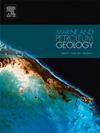Quantification of free and adsorbed fluid content in shale oil reservoirs: Insights from preserved cores and different methods
IF 3.7
2区 地球科学
Q1 GEOSCIENCES, MULTIDISCIPLINARY
引用次数: 0
Abstract
Developing an accurate assessment of the content of in-situ fluid in different states (adsorbed and free) within complex shale reservoirs is crucial for reserve evaluation and shale oil mobility. While various methods based on nuclear magnetic resonance (NMR) technology, such as the two-dimensional (2D) NMR Chart method, Heating method, and Centrifugal method, have been proposed and tested by researchers for evaluating the content of free and adsorbed oil/water in shale reservoirs, a comprehensive comparative analysis of these methods is lacking. Moreover, previous investigations have predominantly focused on NMR analysis of shale samples saturated with single-phase fluids (either oil or water), neglecting the significant impact of oil-water two-phase in-situ fluids on experimental outcomes. Therefore, this study employed 23 preserved initial shale core samples from the Paleogene Shahejie Formation in Bohai Bay Basin, eastern China, and conducted a series of NMR experiments for shale samples under initial, centrifugal, and heating conditions. The content of in-situ oil and water in different states was systematically evaluated using the three aforementioned methods. Key findings include: a. The free oil content evaluated using the Chart method and the Heating method were very similar, both significantly exceeding that obtained via the Centrifugal method, likely due to the ladder-like manner of fluid expulsion from the shale during the centrifugal process and the influence of oil-water two-phase interactions on the Centrifugal method. b. Direct evaluation of free and adsorbed water using the Chart method proved challenging for preserved samples, necessitating auxiliary pretreatment steps such as sample heating to determine appropriate T2 cutoff values. c. The Heating method demonstrated limitations, including incomplete release of free fluid at the threshold temperature and premature expulsion of some adsorbed fluid prior to reaching the threshold, resulting in a slight underestimation of free fluid and an overestimation of adsorbed fluid. Given these observations, it is recommended that a combined approach incorporating the Chart method with the Heating method be employed for a comprehensive evaluation of fluid content in tight shale reservoirs saturated with multiphase fluids. These findings contribute valuable insights for quantifying the content of in-situ free and adsorbed fluids in unconventional reservoirs.
求助全文
约1分钟内获得全文
求助全文
来源期刊

Marine and Petroleum Geology
地学-地球科学综合
CiteScore
8.80
自引率
14.30%
发文量
475
审稿时长
63 days
期刊介绍:
Marine and Petroleum Geology is the pre-eminent international forum for the exchange of multidisciplinary concepts, interpretations and techniques for all concerned with marine and petroleum geology in industry, government and academia. Rapid bimonthly publication allows early communications of papers or short communications to the geoscience community.
Marine and Petroleum Geology is essential reading for geologists, geophysicists and explorationists in industry, government and academia working in the following areas: marine geology; basin analysis and evaluation; organic geochemistry; reserve/resource estimation; seismic stratigraphy; thermal models of basic evolution; sedimentary geology; continental margins; geophysical interpretation; structural geology/tectonics; formation evaluation techniques; well logging.
 求助内容:
求助内容: 应助结果提醒方式:
应助结果提醒方式:


